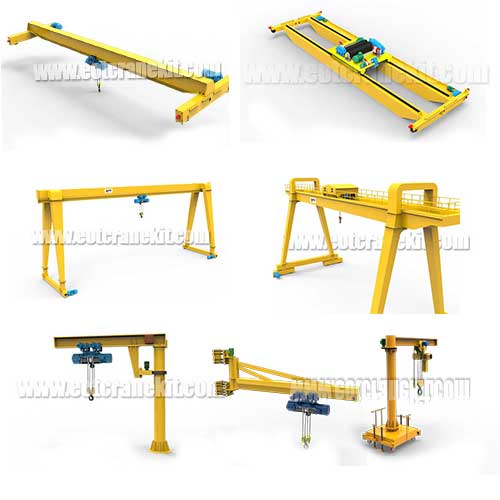Overhead Crane Types: All Types of Overhead Cranes for Sale in China
Types of overhead crane for sale In China, 1 ton - 320 ton cost-effective Chinese style overhead crane & Advanced Euro bridge crane for your selection.
Category: Crane Basics
Your Trusted Overhead Crane Manufacturer & Supplier
Overhead Crane Types: All Types of Overhead Cranes for Sale in China
1 ton - 320 ton cost-effective Chinese types of overhead cranes
Before choosing the specific overhead crane for your application, it is crucial to understand the various types of overhead cranes that are available as well as the features and benefits of each type. You can choose the crane types, working duty class, space requirements, and financial constraints that will work best for you once you have the necessary information.
In this blog, we'll go over the benefits and applications of the five main types of overhead cranes, as well as the available configurations.
5 Main Types of Electric Overhead Cranes
Here are the 5 basic types of overhead cranes :
Light Lifting Equipment:Light lifting equipment - The types of lifting equipment, mainly consisted of Electric hoist, chain hoist, electric chain hoist, miniature hoist, etc.. The light hoisting equipment is designed with the features of light and compact structure, light weight, small size, and strong versatility of parts, etc.
- Manuel chain hoist
- Electric chain hoist
- Electric wire rope hoist
- Monorail hoist and crane systems
- Portable cranes
- Bridge Cranes
Overhead Bridge Crane
Overhead bridge crane - The bridge crane is the most common used material handling equipment. It is erected on the track mounted on the crane runways supported or partially supported by the inner building structure. They are widely used in workshops and warehouses, for loading and unloading works and heavy loads or object handling works indoors and outdoors. They are also called overhead travelling bridge crane, overhead crane, and eot crane, and overhead gantry crane, etc.
- - Single Girder and Double Girder Bridge Cranes
- - Top Running and Underhung Bridge Cranes
Gantry Cranes
Gantry crane - The gantry cranes are similar with bridge crane, with self supporting legs running on the rails, embedded on the ground, instead of on the runway beams supported by building structure. It is generally called gantry crane or Goliath crane in the factory.
- - Single girder gantry crane
- - Double girder gantry crane
Rotating jib crane
Jib type crane - The types of cranes covers portal cranes, fixed slewing cranes, shore-to-shore container bridge cranes, etc.
- Wall travelling crane
- Wall mounted crane
- Floor mounted pillar jib crane
- Workstation Cranes
Workstation Crane
A workstation crane is a type of overhead crane that is designed for light-duty applications and is typically used in a smaller work area, such as a manufacturing cell or assembly station. These cranes are often used to move materials or products from one workstation to another, and they are typically operated manually.
There are several types of workstation cranes, including:
- Freestanding workstation cranes
- Ceiling-mounted workstation cranes
- Kbk crane
Your Trusted Overhead Crane Manufacturer & Supplier
Light lifting equipment: Types of Manual Hoist and Electric Hoists
Manual and Electric Chain Hoist and Electric Wire Rope hoists
Manual chain hoist
It is also called chain block, manual hoist, hand hoist, or hand operated hoist, etc.
It is a manual lifting machine that is easy to use and easy to carry. It is suitable for short-distance lifting and transportation of small equipment and goods. The lifting capacity of manual chain hoist generally does not exceed 100 ton. The shell of the chain hoist is made of high-quality alloy steel, which is strong and wear-resistant, and has high safety performance.
Famous brands of chain hoists -Korea (DK) black bear, Japan (SPEED) Erye, Japanese (KITO) Ghost Head,Japan (TOYO) Toyo,Japan (EAGLE) Eagle,etc.
Manual chain hoists, also known as hand chain hoists, are a type of material handling equipment that are operated manually by pulling a chain to lift and move heavy loads. There are several types of manual chain hoists, including:
- Hook Mounted Manual Chain Hoist: This type of manual chain hoist is mounted on a hook and can be attached to a trolley or other lifting device.
- Trolley Mounted Manual Chain Hoist: This type of manual chain hoist is mounted to a trolley that moves along a beam or track, allowing the hoist to move horizontally as well as vertically.
- Low Headroom Manual Chain Hoist: This type of manual chain hoist is designed for use in areas with limited headroom, where a traditional hoist would not fit.
- Geared Manual Chain Hoist: This type of manual chain hoist is designed for use in applications where precise load control is required. It features a gear system that allows for slow and controlled lifting and lowering of loads.
- Lever Manual Chain Hoist: This type of manual chain hoist is operated by pulling a lever to lift and move loads. It is typically used in applications where the operator needs to maintain control over the load at all times.
- Explosion-proof manual chain hoists are designed for use in hazardous environments where there is a risk of explosion due to the presence of flammable gases or vapors. These hoists are constructed with special materials and features that prevent sparks from being generated during operation, reducing the risk of ignition.
- Stainless steel chain hoists are designed for use in applications where corrosion resistance is important, such as in food processing or marine environments. These hoists are constructed with stainless steel components that are resistant to rust and other forms of corrosion.

Hand chain hoist

Hand push chain hoist
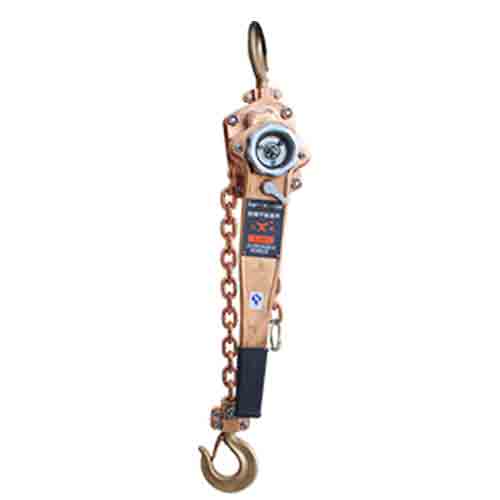
Lever chain hoists

Low headroom chain hoist
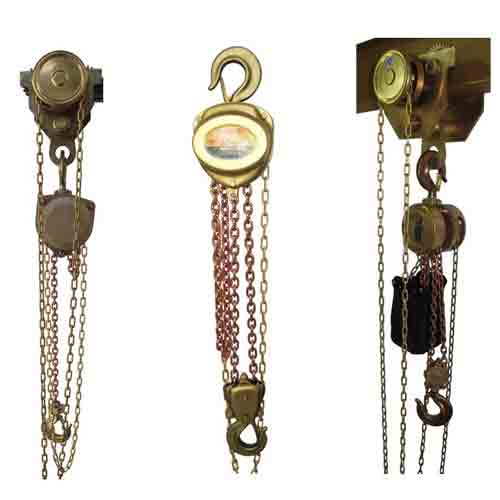
Explosion proof
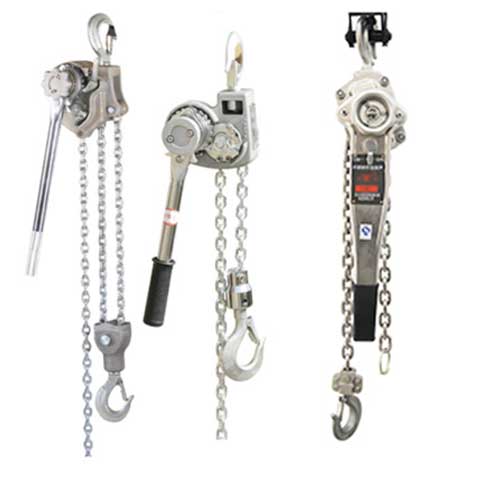
Stainless steel chain hoist
Manual chain hoists are typically used in applications where electricity is not available or where a power source is not practical. They offer several advantages, including:
- Good performance and easy maintenance. They are cost-effective and require minimal maintenance.
- They are easy to operate and require minimal training.
- In line with national standards, safe and reliable, durable.
- Strong toughness, small size, light weight, easy to carry
- Small hand pulling force and high mechanical strength
- Advanced structure and beautiful appearance
- Lifting goods in areas without power supply
- They can be used in a variety of settings, including construction sites, warehouses, and assembly lines.
- However, manual chain hoists also have some limitations, including:
- They have lower lifting capacities than electric or hydraulic hoists.
- They may require more physical effort to operate than other types of hoists.
- They may not be suitable for applications where high speeds or long travel distances are required.
Electric chain hoists
An electric chain hoist is a type of material handling equipment that is used to lift and move heavy loads. It consists of a motorized chain that runs through a hoist unit, which is suspended from a trolley that moves along a beam or track. Electric chain hoists are commonly used in manufacturing and industrial settings.
There are several types of electric chain hoists, including:
- Hook Mounted Electric Chain Hoist: This type of electric chain hoist is mounted on a hook and can be attached to a trolley or other lifting device.
- Trolley Mounted Electric Chain Hoist: This type of electric chain hoist is mounted to a trolley that moves along a beam or track, allowing the hoist to move horizontally as well as vertically.
- Low Headroom Electric Chain Hoist: This type of electric chain hoist is designed for use in areas with limited headroom, where a traditional hoist would not fit.
- Explosion-proof electric chain hoists are designed for use in hazardous environments where there is a risk of explosion due to the presence of flammable gases or vapors. These hoists are constructed with special materials and features that prevent sparks from being generated during operation, reducing the risk of ignition.
- European-style electric chain hoists, also known as low headroom hoists, are designed for use in areas with limited headroom. These hoists feature a compact design that allows them to be installed in areas with low ceilings or other obstructions. They are typically used in manufacturing and industrial settings where space is at a premium.

Electric trolley electric chain hoist

Manual trolley electric chain hoist
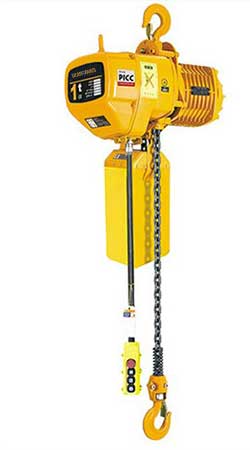
Hook mounted electric chain hoist

Low headroom electric chain hoist
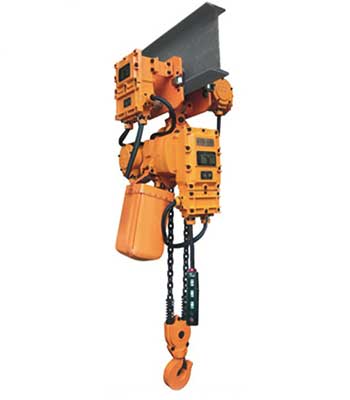
Explosion proof electric chain hoist
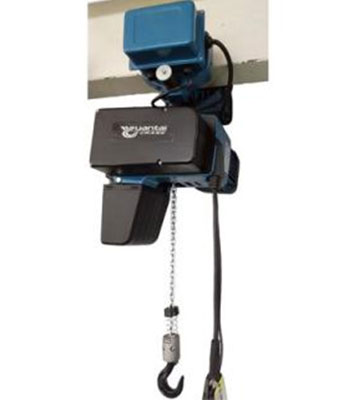
European style electric chain hoist
Features of electric chain hoists include:
- They are available in a range of lifting capacities, from a few hundred pounds to several tons.
- They are easy to operate and require minimal training.
- They can be used in a variety of applications, including assembly lines, warehouses, and construction sites.
- They can be customized to fit specific applications.
Advantages of electric chain hoists include:
- They are cost-effective and require less maintenance than other types of hoists.
- They are easy to install and can be used in a variety of settings.
- They are relatively quiet and produce less vibration than other types of hoists.
- Limitations of electric chain hoists include:
- They have lower lifting capacities than other types of hoists, such as wire rope hoists.
- They may not be suitable for applications where high speeds or long travel distances are required.
- They may require additional support structures to be installed in the building
Electric wire rope hoists
Electric wire rope hoists are a type of material handling equipment that are used to lift and move heavy loads. They consist of a motorized drum that rotates a steel cable or wire rope, which is attached to a hoist unit that moves up and down to lift and lower the load. Electric wire rope hoists are commonly used in manufacturing and industrial settings.
Main series of electric wire rope hoists
The different types of electric wire rope hoists:
- CD1—ordinary single-speed electric hoist: This type of hoist has a single lifting speed and is suitable for applications where precise load control is not required. It is commonly used in manufacturing and industrial settings.
- MD1—ordinary two-speed electric hoist: This type of hoist has two lifting speeds and is suitable for applications where precise load control is required. It is commonly used in manufacturing and industrial settings.
- YH—metallurgical electric hoist: This type of hoist is designed for use in metallurgical applications, such as steel mills or foundries. It is constructed with specialized materials that can withstand high temperatures and harsh environments.
- BCD—Explosion-proof electric hoist: This type of hoist is designed for use in hazardous environments where there is a risk of explosion due to the presence of flammable gases or vapors. It is constructed with special materials and features that prevent sparks from being generated during operation, reducing the risk of ignition.
- GD(CD)—Low Headroom Single Speed Electric Hoist: This type of hoist is designed for use in areas with limited headroom, where a traditional hoist would not fit. It has a compact design that allows it to be installed in areas with low ceilings or other obstructions.
- GSD(MD)—low headroom two-speed electric hoist: This type of hoist is similar to the GD(CD) hoist, but has two lifting speeds and is suitable for applications where precise load control is required.
All of these types of electric wire rope hoists offer several advantages, including:
- They are available in a range of lifting capacities to meet specific application requirements.
- They offer precise load control and can be used to move materials in a variety of directions.
- They can be operated remotely, which increases operator safety and allows for greater flexibility in operation.
- However, each type of hoist also has its own unique features and limitations, which should be considered when selecting the appropriate hoist for a particular application.
Marking explanation:
Take a metallurgical electric hoists for example. If the required specifications are as following:
- The rated lifting capacity is 5 ton.
- The lifting height is 12m, and
- the working duty of metallurgical use trolley travelling electric wire rope hoist is M6.
The electric hoist with above specifications shall be marked as: YH 5t-12m M6
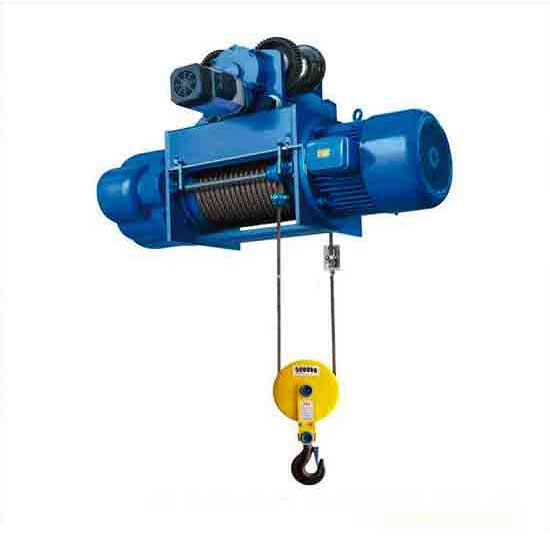
Cd/md
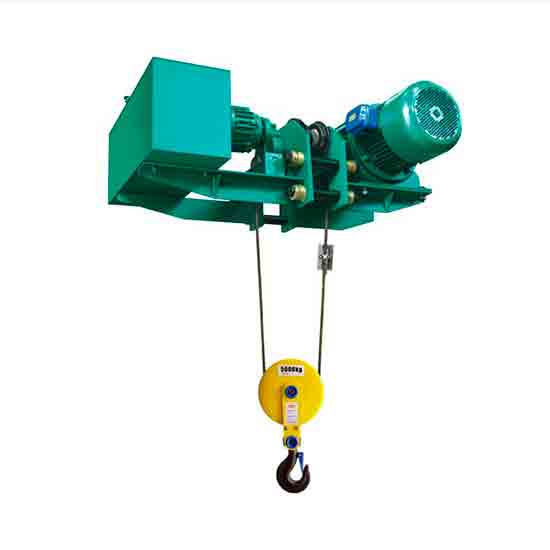
Low headroom

Explosion proof
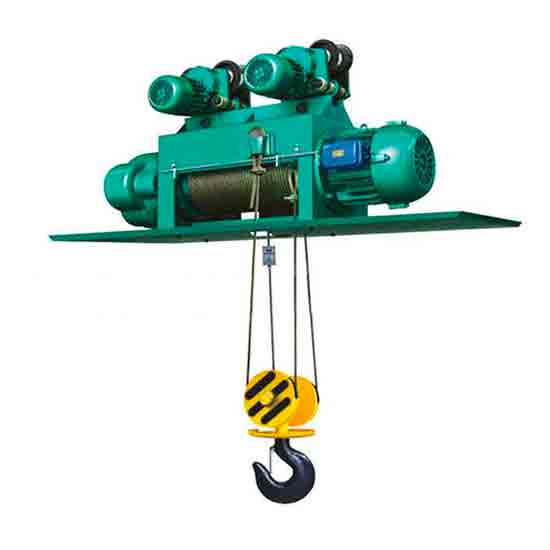
Metallurgical

Fixed wire rope hoist
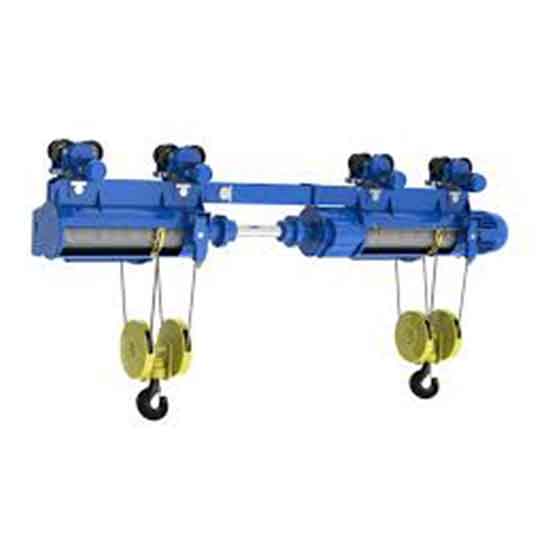
Double hook
Monorail Hoists and Monorail Crane System
Monorail hoists and monorail cranes are types of material handling equipment that are commonly used in manufacturing and industrial settings.
A monorail hoist is a type of hoist that runs on a single rail or beam, while a monorail crane consists of a single girder bridge that runs on a single rail or beam.Molds and dimensions of I beams-P15 14.2kg/m , P18 17.2kg/m, P22 21.2kg/m, P24 23.2kg/m , P30 28.2kg/m ,P38 37kg/m ,P43 42.3kg/m,QU70 51kg/m , QU80 61.3kg/m, QU100 84.3kg/m , QU120 113kg/m .
There are several types of monorail cranes, including:
- Underhung Monorail Crane: This type of monorail crane is suspended from the building structure and runs on a single rail or beam.
- Top Running Monorail Crane: This type of monorail crane runs on a single rail or beam that is supported by columns or other structures.
- Single Girder Monorail Crane: This type of monorail crane consists of a single girder bridge that runs on a single rail or beam.
Features of monorail cranes include:
- They require less space than traditional overhead cranes.
- They can be customized to fit specific applications.
- They can be used to move materials in a straight line or along a curved path.
- Advantages of monorail cranes include:
- They are cost-effective and require less maintenance than traditional overhead cranes.
- They can be used in areas with limited space.
- They can be used to move materials in a variety of directions.
- Limitations of monorail cranes include:
- They have lower lifting capacities than traditional overhead cranes.
- They may not be suitable for applications that require high-speed or long-travel movements.
- They may require additional support structures to be installed in the building.
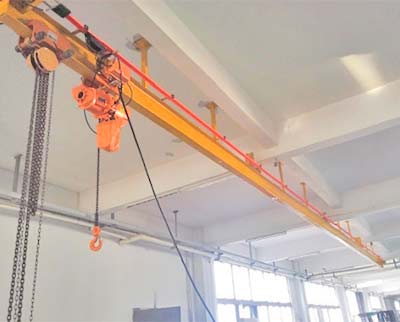
Ceiling mounted monorail cranes with H beam
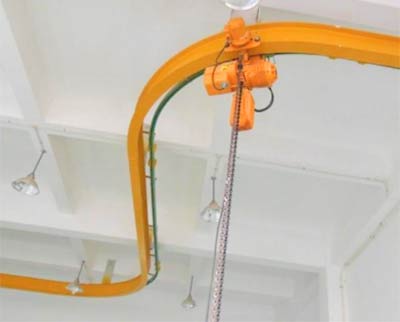
Ceiling mounted monorail crane with curved beam
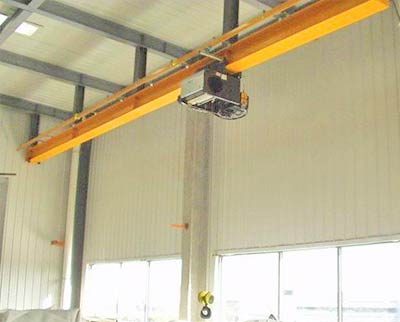
Straight monorail crane with european style hoist
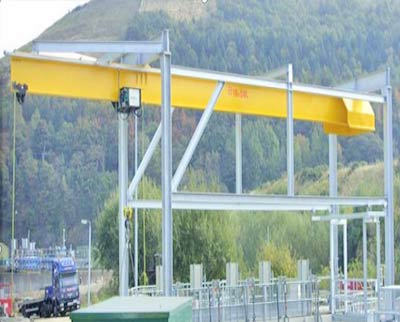
Freestanding monorail cranes
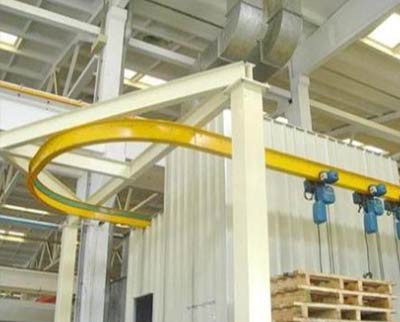
U shape monorail rail
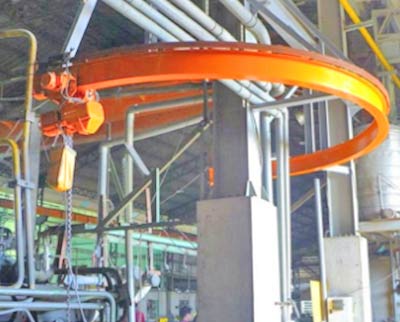
Curved monorail rail
Your Trusted Overhead Crane Manufacturer & Supplier
Bridge Cranes
Single / Double Girder & Top Running / Underhung Crane
Bridge cranes, also known as overhead cranes, are a type of material handling equipment that are commonly used in industrial and manufacturing settings. They consist of a bridge or beam that spans the width of a building, and one or more hoists that move along the bridge to lift and move heavy loads.
Main types of bridge cranes
Bridge cranes can be classified into different classifications based on different standards. In the following, main types of overhead crane types are presented for your reference.
1. According to overhead crane structure: There are single-girder bridge crane type, double-girder bridge crane type, multi-girder bridge crane such as four girder crane for casting industry, double trolley bridge type, and multi hoist and trolley bridge crane type, etc.
2. According to the pick-up device/ below-hook-devices: They can be classified hook bridge crane, grab bridge crane, electromagnetic bridge crane, container bridge crane, etc.
3. According to the purpose or applications: There are general bridge crane, metallurgical bridge crane, explosion-proof bridge crane and so on.
Single girder & Double Girder Bridge Cranes
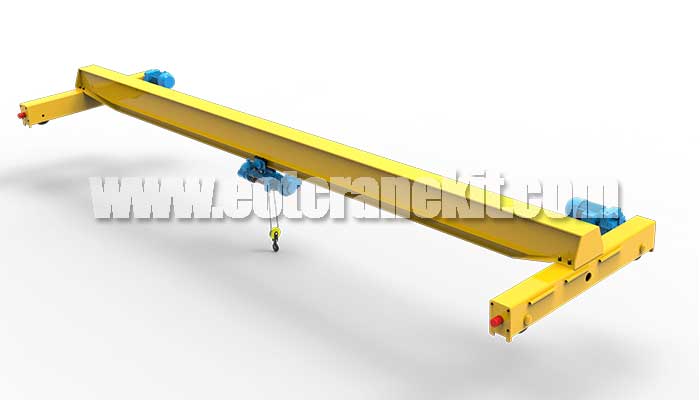
Single girder bridge cranes
Single Girder Cranes - The crane consists of a single bridge girder supported on two end trucks. It has a trolley hoist mechanism that runs on the bottom flange of the bridge girder.
Basic structure of Chinese style electric single girder crane
- Bridge frame with operating mechanism and electric hoist moving along the lower flange of main beam which consisted of U shaped box girder and I beam steel.
- Electric hoist - is used for lifting heavy objects and running along the main beam, which is used as the lifting trolley of the bridge crane.
- Composition: bridge frame + crane running mechanism + electric hoist + electrical equipment.
- Features: Large lifting capacity, high working speed and high production efficiency.
- Main specifications - 1-20 ton
The advantages of double girder overhead cranes include high lifting capacity, increased height, greater stability, customizability, and versatility. Additionally, overhead cranes do not require floor space, making them ideal for industrial settings with limited space.
Main types of Single Girder Overhead Crane
The main types and moldes of bridge cranes in China are marked with the following:
- LD - electric single beam crane (LDA)
- LX— electric single girder suspension crane
- LB— Explosion-proof electric single beam crane
- LDY—Metallurgical Electric Single Girder Crane
- SL— Manual Single Beam Crane
- SLX—Manual Single Girder Suspension Crane
- LDP -low headroom single girder overhead crane
- LDE - Single girder overhead crane with double hoist trolley
- LZ - Single girder overhead crane with grab bucket
- HD- single girder overhead crane with European style design
- NLX -European type single girder suspension overhead crane

Double girder bridge crane
Double Girder Bridge Cranes - The crane consists of two bridge girders supported on two end trucks. The trolley runs on rails on the top of the bridge girders.
Main structure of double girder bridge crane
- Generally, it consists of a bridge frame, a crab hoist trolley running mechanism, a lifting trolley mechanism (with a lifting system and travelling trolley system ), crane operating system and electrics, etc.
- The double beam bridges are mainly consisted of main girder, end girder, trolley running track, railing, walking platform, driver's cab, etc.
- It is the main component of the bridge crane,which bears various loads, and should have sufficient rigidity and strength. Strength is the ability to resist fracture, and stiffness is the ability to resist deformation.
- Features - Material: Q235B or Q345B , Structural form: box type
- Main specification- 1 -320 ton
Because the main girder of the box structure has many advantages such as high overall rigidity, good manufacturing, assembly, transportation and maintenance conditions,and it is widely used at home and abroad.
Main types of overhead cranes
The main types and molds of bridge cranes made in China are marked as the following :
- LH— electric hoist bridge crane ( Comparied with Euroepan type electric hoist overhead crane )
- QD— Hook Overhead Crane (Universal Overhead Crane) ( Comparison with European type double girder overhead crane )
- QDY—casting bridge crane
- QZ— Grab bridge crane
- QB— Explosion-proof bridge crane
- QE— double trolley hook bridge crane
- QY— insulated bridge crane
- QC— Electromagnetic Bridge Crane
- QG— Hanging girder bridge crane
- QL— Electromagnetic hanging beam bridge crane
- SQ— Manual Double Girder Crane
- LHB—Explosion-proof electric hoist bridge crane
Types of traditional single girder overhead crane economical price

Crane type:LDA
Lifting capacity:1-20ton
Lifting height6-30m
Crane span:7.5-28.5m
Working class:A3-A5

Crane type:LX
Lifting capacity:0.5-10ton
Lifting height6、9、12、18m
Crane span:3-16m
Working class:A3-A5

Crane type:LB
Lifting capacity:1-16ton
Lifting height6、9、12、18、24m
Crane span:7.5-28.5m
Working class:A3

Crane type:LX explosion proof overhead crane
Lifting capacity:0.5-10ton
Lifting height6、9、12、18m
Crane span:3-16m
Working class:A3

Crane type:LDY
Lifting capacity:1-10ton
Lifting height9、12、15、18、20m
Crane span:7.5-28.5m
Working class:A6
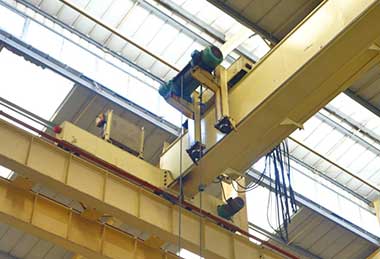
Crane type:LDP
Lifting capacity:3~10ton
Lifting height6、9、12m
Crane span:7.5-22.5m
Working class:A3、A4

Crane type:LDE
Lifting capacity:(5+5)ton(10+10)ton
Lifting height6、9、12、18、24、30m
Crane span:7.5-22.5m
Working class:A3

Crane type:SL
Lifting capacity:1-5ton
Lifting height1-6m
Crane span:1-10M
Working class:A3

Crane type:LDZ
Lifting capacity:3-10ton
Lifting height9、12、15、18、20m
Crane span:4.5-28.5m
Working class:A5
Types of Chinese type double girder bridge cranes, reliable and cost-effective

Crane type:LH
Lifting capacity:5、10/3、16/3、20/5、32/10ton
Lifting height6、9、12、18、24、30m
Crane span:7.5-25.5m
Working class:A3-A5

Crane type:QD
Lifting capacity:5-450ton
Lifting height26m
Crane span:10.5-31m
Working class:A5、A6

Crane type:QB
Lifting capacity:5-75ton
Lifting height14-22m
Crane span:10.5-31.5m
Working class:A4

Crane type:QE
Lifting capacity:5-16ton
Lifting height16m
Crane span:10.5- 31.5m
Working class:A5、A6

Crane type:QDY
Lifting capacity:< 75ton
Lifting height20m
Crane span:10.5-31.5m
Working class:A7

Crane type:QZ
Lifting capacity:5、10、16、20ton
Lifting height18、20、26、28m
Crane span:10.5-31.5m
Working class:A6

Crane type:QC
Lifting capacity:5-32/5ton
Lifting height18m
Crane span:10.5-31.5m
Working class:A6

Crane type:QL
Lifting capacity:(5+5)-(20+20)ton
Lifting height12-16m
Crane span:10.5-31.5m
Working class:A6、 A7

Crane type:QN
Lifting capacity:5、10、16ton
Lifting height22m
Crane span:10.5-31.5m
Working class:A6
Under Running (U/R) & Top Running (T/R) Bridge Travelling Cranes
Top running vs. underhung
This is the section of the bridge where the trolley and hoist system is installed and operates.
- Top-running configurations -Due to the fact that the trolley and hoist are supported by the runway support columns, top-running configurations are perfect for lifting extremely heavy loads.
- Under hung crane configurations - In an underhung configuration, the trolley and hoist are connected and run along the bridge's lower flange. Underhung trolley and hoist configurations are an excellent way to maximize space in your facility.

Top Running Cranes
Oveview - The crane bridge travels on top of rails mounted on a runway beam supported by either the building columns or columns specifically engineered for the crane. Top running canes are the most common form of crane design where the crane loads are transmitted to the building columns or free standing structure. These cranes have the greatest variation in capacity, span and service class and usually span the full width of the framing supports. These are available in both single girder and double girder configuration.
Basic structure of single girder top running crane
A top running single girder overhead crane is a type of crane that has a single beam spanning the width of a building and is supported by two end trucks. The hoist and trolley run on the bottom flange of the beam.
Advantages of a top running single girder overhead crane include:
- Cost-effective: Single girder cranes are generally less expensive than double girder cranes.
- Space-saving: Single girder cranes take up less space than double girder cranes, making them ideal for smaller facilities.
- Ease of maintenance: Because there is only one girder, maintenance is generally easier and less time-consuming.
Limitations of a top running single girder overhead crane include:
- Lower capacity: Single girder cranes typically have a lower capacity than double girder cranes.
- Limited span: Single girder cranes are typically limited in span compared to double girder cranes.
- Limited lift height: Single girder cranes may not be able to lift loads as high as double girder cranes.
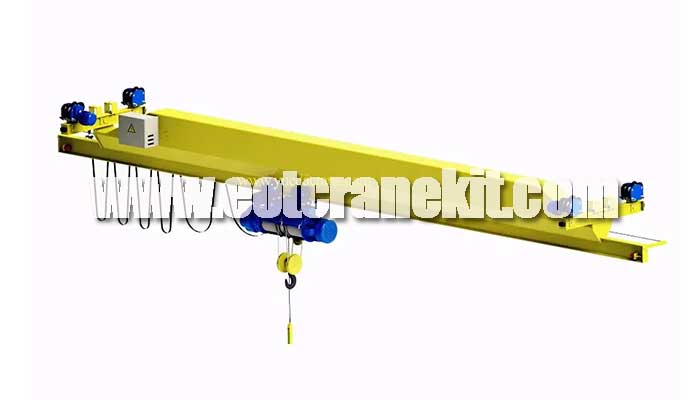
Under running cranes
Overview - Under running or under slung cranes are supported by using a suspension type support which is connected to the bottom of the frame. The crane wheels are supported from the bottom of flange of the crane beams which act as a crane rail and usually only span a portion of the column-to-column span of the structure. Under running cranes are typically available in standard capacities up to 10 tons (special configurations up to 25 tons and over 90 ft spans). Under hung cranes offer excellent side approaches, close headroom and can be supported on runways hung from existing building members if adequate.
Basic structure of electric single girder suspension crane
The underhung bridge crane is basically similar to the top running electric single-girder crane. The main difference is that the underrunning crane is not supported and travelling on the top of runway beams between the spans of the building, but is suspended on the lower flange of the I-beam by using four pulleys mounted on the beam.
Advantages:
- simple structure, light weight, cheap price.
- And they can be installed on the ceiling or roof structure and used in relatively low factory buildings or warehouses, which is an cost-effective bridge crane by saving the cost of the crane supporting columns.
Limitations:
- There must be a roof truss or beam of sufficient strength to bear the self-weight, lifting load and dynamic load of the crane, so the lifting capacity of this underslung bridge crane should not be too large.
- At present, the maximum lifting capacity of undehrung bridge crane made by Chinese crane manufacturers and supplier are 10 ton.
Bridge cranes types based on the lifting devices
According to the pick-up device: such as hook bridge crane, grab bridge crane, electromagnetic bridge crane, container bridge crane, etc.
Overhead cranes are a type of material handling equipment that are used to lift and move heavy loads in manufacturing and industrial settings. There are several types of overhead crane attachments that can be used to increase the versatility and functionality of these cranes. Here are some examples:

Hook
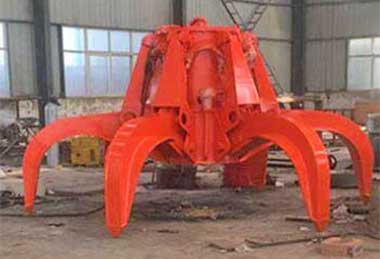
grab
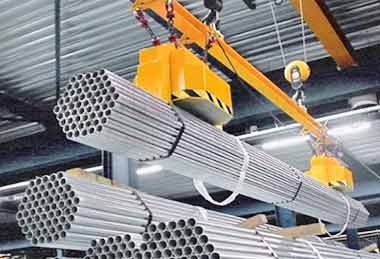
magnets
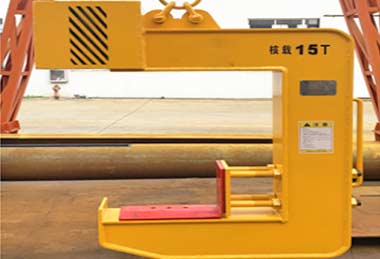
c hook
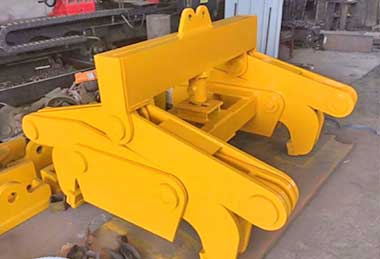
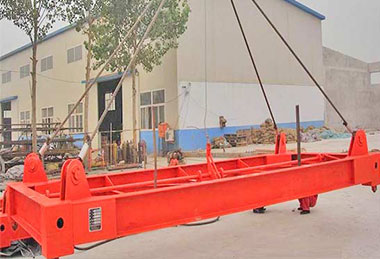
Spreader
- Hook Block: This is a basic attachment that is used to lift loads using a hook. Hook blocks are available in a range of sizes and capacities to meet specific application requirements.
- Lifting Magnets: These attachments use magnetic force to lift and move ferrous materials, such as steel plates or sheets. They are commonly used in metalworking and fabrication applications.
- Grabs: These attachments are used to lift and move bulk materials, such as sand, gravel, or scrap metal. They come in a variety of designs, including clamshell grabs, orange peel grabs, and bucket grabs.
- C-Hooks: These attachments are used to lift and move coils or other cylindrical loads. They are designed with a curved shape that allows them to securely grip the load.
- Spreader Beams: These attachments are used to distribute the weight of a load evenly across multiple lifting points. They are commonly used in applications where a load is too long or awkwardly shaped to be lifted with a single attachment point.
- Vacuum Lifters: These attachments use suction cups or a vacuum to lift and move materials, such as glass or plastic sheets. They are commonly used in manufacturing and assembly applications.
- Pallet Lifters: These attachments are used to lift and move pallets or other large containers. They are designed with fork-like tines that can be inserted into the pallet or container.
- Each type of overhead crane attachment offers its own unique advantages and limitations, and should be selected based on the specific requirements of the application.
Types of overhead cranes based on the uses or functions
According to the purpose or functions of cranes, the bridge cranes can be classified into general use bridge crane, metallurgical bridge crane, explosion-proof bridge crane and so on.
Overhead crane types | Classification | Application |
General overhead crane | Hook overhead crane, grab bridge crane, electromagnetic bridge crane, 2- purpose overhead crane, 3- purpose overhead crane | Machining workshop, assembly workshop, power plant, warehouse, storage yard |
Metallurgical bridge crane | Casting bridge crane, clamp crane, ingot stripping crane, feeding crane and forging crane | Steel Plant |
Explosion-proof bridge crane/ Hazardous use overhead cranes | Explosion-proof bridge crane for coal mine; explosion-proof bridge crane for factory | Coal mines, factories with flammable and explosive mixtures |
Your Trusted Overhead Crane Manufacturer & Supplier
Gantry Crane
Main types of gantry cranes
With gantry cranes, the trolley and hoist mechanism still travels along a bridge but is supported by legs rather than runways. They are therefore perfect for outdoor situations where installing columns is not an option. For instance, fixed- or track-mounted gantry cranes are frequently utilized for those applications in shipyards and railyards.
Gantry cranes are adaptable and come in portable and adjustable models. Gantry cranes are especially helpful in situations where lifting is not usually needed, like in a motor repair shop, etc.
Main types of gantry cranesBased on different classifications standards, the gantry cranes can be classified into different crane types:
There are many classifications of gantry cranes:
- 1. According to the structure: single main girder gantry crane, double main girder gantry crane, box type or truss type gantry crane.
- 2. According to the cantilever: single cantilever gantry crane, double cantilever, no cantilever gantry crane, etc.
- 3. According to the support method: rail-mounted gantry cranes, tire-type gantry cranes.
- 4. According to the pick-up device: hook gantry crane, grab gantry crane, electromagnetic gantry crane, etc.
- 5. According to the application occasion: general purpose gantry crane, shipbuilding gantry crane, hydropower station gantry crane, etc.
Single girder gantry crane & double girder gantry cranes
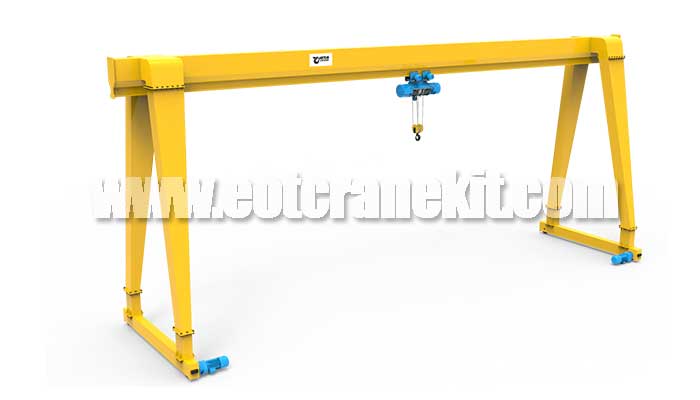
A single girder gantry crane is a type of gantry crane that has a single main girder spanning between two legs. It is commonly used in outdoor applications, such as in shipyards, construction sites, and storage yards.
Features of a single girder gantry crane include:
- Cost-effective: Single girder gantry cranes are typically less expensive than double girder gantry cranes, making them a cost-effective solution for many outdoor lifting applications.
- Versatile: Single girder gantry cranes can be designed to handle a wide range of load capacities and sizes, making them suitable for a variety of applications.
- Easy to install: Single girder gantry cranes are typically easier to install than other types of cranes, such as bridge cranes or jib cranes.
- Space-saving: Single girder gantry cranes take up less space than other types of cranes, such as bridge cranes or jib cranes. This makes them ideal for use in areas where space is limited.
- Mobility: Single girder gantry cranes can be mounted on wheels or rails for mobility, allowing them to be easily moved between work areas.
Overall, single girder gantry cranes are a versatile and cost-effective solution for many outdoor lifting applications. They offer a range of features and can be customized to meet the specific needs of a particular application.
Types of single girder gantry crane
- The symbols are: MDG, MDE, MDZ, MDC, MDN, MDP, MDS, MH, MBH
- Such as: MDG- single girder single trolley hook gantry crane
- MDE- Single girder double trolley hook gantry crane
- MDZ- Single Beam Grab Gantry Crane
- MDC- Single Beam Electromagnetic Gantry Crane
- MDN—single girder single trolley grab hook gantry crane
- MDP-S ingle Beam Grab Electromagnetic Gantry Crane
- MDS—Single girder three-purpose gantry crane
- MH— electric hoist gantry crane
- MBH-Electric hoist semi-gantry crane
- Portable gantry crane - Fixed height & adjustable height gantry cranes
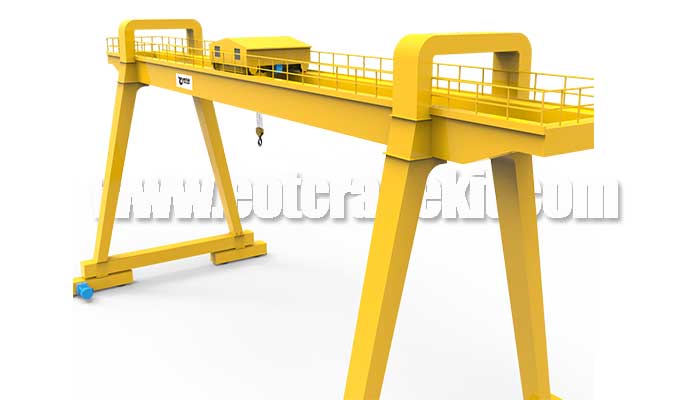
Double girder gantry cranes are heavy-duty cranes that are used to lift and move large and heavy objects in industrial settings such as factories, shipyards, and construction sites.
Features of double girder gantry cranes include:
- High lifting capacity: Double girder gantry cranes have a higher lifting capacity than single girder gantry cranes, making them ideal for lifting and moving heavy loads.
- Increased height: The double girder design allows for a higher hook height, which is beneficial for lifting and moving objects that require additional clearance.
- Greater stability: Double girder gantry cranes are more stable than single girder gantry cranes, which allows for greater precision during lifting and movement.
- Customizable: Double girder gantry cranes can be customized with various lifting attachments and safety features to meet specific industrial needs.
- Versatile: Double girder gantry cranes can be used in both indoor and outdoor settings, making them a versatile option for various industries.
Double girder gantry cranes have several advantages, including high lifting capacity, increased height, greater stability, customizability, and versatility. These features make them an ideal choice for lifting and moving heavy loads in various industrial settings.
Types of Double girder gantry crane
- The symbols are: MG, ME, MZ, MC, MP, MS, RMG, RTG
- Such as: MG—double girder single trolley hook gantry crane
- ME—Double girder double trolley hook gantry crane
- MZ- double girder grab bucket gantry crane
- MC-Double beam electromagnetic gantry crane
- MP- Double Beam Grab Electromagnetic Gantry Crane
- MS- Double girder three-purpose gantry crane
- RMG- Rail Mounted Container Gantry Crane
- RTG-Tire Type Container Gantry Crane
Types of gantry cranes based on gantry supporting legs

Crane type:MH
Lifting capacity:3-16ton
Lifting height9m
Crane span:12-30m
Working class:A3

Crane type:MG
Lifting capacity:Up to 500ton
Lifting height12m
Crane span:18-35m
Working class:A5

Crane type:MHZ
Lifting capacity:5-10ton
Lifting height9m
Crane span:12-30m
Working class:A5

Crane type:MDG
Lifting capacity:5-32/5ton
Lifting height11m
Crane span:18-35m
Working class:A5

Crane type:MZ
Lifting capacity:5ton、10ton
Lifting height18m
Crane span:18-35m
Working class:A6

Crane type:L
Lifting capacity:5-10ton
Lifting height9m
Crane span:16-30m
Working class:A5

Crane type:MHE
Lifting capacity:(1+1)-(20+20)ton
Lifting height7.5-22m
Crane span:5-20m
Working class:A3-A5

Crane type:MHB
Lifting capacity:5-10ton
Lifting height6m
Crane span:10-20m
Working class:A4

Crane type:BMH
Lifting capacity:5-10ton
Lifting height6m
Crane span:10-20m
Working class:A4

Crane type:Portable gantry crane
Lifting capacity:1-5ton
Lifting height6m
Crane span:10m
Working class:light duty
- A-frame gantry crane type: This type of gantry crane has two vertical A-shaped legs that are connected at the top by a horizontal beam. The trolley, which carries the load, runs along the horizontal beam. This design offers high stability and is suitable for heavy-duty lifting applications.
- U-shaped gantry crane type: This type of gantry crane has two parallel legs that are connected by a U-shaped cross beam. The trolley runs along the bottom flange of the cross beam, and the U shape of the beam provides additional stability. This design is suitable for heavy-duty lifting applications where stability is important.
- L-shape leg gantry crane type: This type of gantry crane has two legs that are shaped like an L. The trolley runs along the bottom flange of the cross beam, and the L shape of the legs provides good stress conditions. This design is suitable for applications where there is limited space for goods to pass through horizontally.
- C-type gantry crane type: This type of gantry crane has two legs that are shaped like a C. The trolley runs along the bottom flange of the cross beam, and the C shape of the legs provides a large horizontal passing space. This design is suitable for applications where there is a need for a large horizontal passing space.
- Semi-gantry crane/single leg gantry crane type: This type of gantry crane has one end of the main beam supported by a vertical leg, while the other end is supported by a runway on the ground. The trolley runs along the bottom flange of the main beam. This design is suitable for applications where there is limited space for installation.
- Truss type gantry cranes: This type of gantry crane has a main beam that is constructed with truss members. The trolley runs along the bottom flange of the main beam, and the truss design provides high strength and stability. This design is suitable for heavy-duty lifting applications.
- Each structural form of gantry crane offers its own unique advantages and limitations, and should be selected based on the specific requirements of the application. Factors to consider when selecting a gantry crane include lifting capacity, span, height, mobility, and support structure for installation.
Selection of Gantry Cranes
1. Selection of single main girder and double girder gantry cranes
Choose according to the lifting tonnage, working speed and cargo size.
- The single main girder type is used when the span is less than 35 meters and there is no special requirement under 50 tons.
- Double-girder type is used when the width of the door foot is large, the working speed is high, or long pieces are often lifted.
2. Span and cantilever length - According to the main factors affecting the crane's self-weight, the span should be kept as small as possible while meeting other requirements.
3. Determination principle of wheelbase - Meet stability requirements; Transverse passability of goods; General wheelbase B=(1/4~1/6)S.
4. Determination of the distance between gantry cranes
During work, there should be a certain space between the external dimensions of the gantry crane and the cargo and transport vehicle passages in the yard to facilitate loading and unloading operations. Generally, when the transport vehicles are loaded and unloaded within the span, there should be a distance of more than 0.7m from the door legs. There should be a distance of more than 0.5m between the spreader and the transport vehicle when it is not working, and a distance of more than 0.5m when the goods pass through the door legs.
Your Trusted Overhead Crane Manufacturer & Supplier
Jib Crane & Cantilever Crane
Main types of jib cranes
Jib cranes are ideal for areas with insufficient headroom and structural support, providing versatile and cost-effective lifting solutions. Jib cranes have limited movement because they cannot move around a facility, but they can be used as supplements to regular traveling cranes and monorail tracks. They can also be used in bays, as well as along the walls and sides of stores. Jib cranes provide 180- or 360-degree movement when mounted to the floor or a wall.
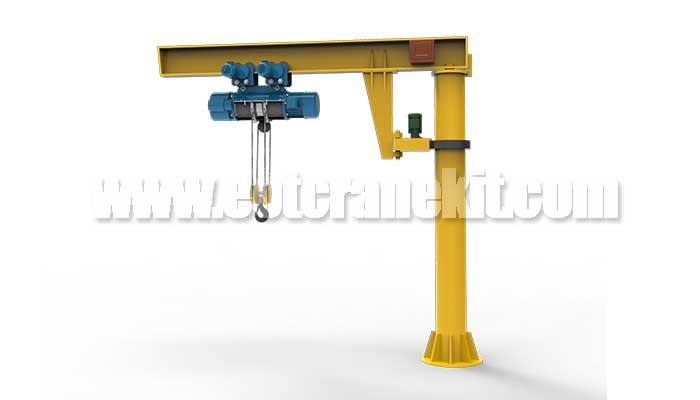
Floor jib crane

Wall jib cranes
Advantages of jib cranes include:
- Versatility: Jib cranes are available in a range of sizes and lifting capacities, making them suitable for a variety of applications. They can be used to lift and move loads in a variety of directions, making them ideal for applications where precise load placement is required.
- Space-saving: Jib cranes take up less floor space than other types of cranes, such as bridge cranes or gantry cranes. This makes them ideal for use in areas where space is limited.
- Cost-effective: Jib cranes are generally less expensive than other types of cranes, making them a cost-effective solution for many applications.
- Easy to install: Jib cranes can be installed quickly and easily, often with minimal disruption to existing operations.
- Increased safety: Jib cranes can be operated remotely, which increases operator safety and reduces the risk of accidents. They also offer precise load control, which reduces the risk of damage to the load or surrounding equipment.
- Overall, jib cranes are a versatile and cost-effective solution for many material handling applications. They offer several advantages over other types of cranes, including space-saving design, easy installation, and increased safety.
Limitations of jib cranes
- While jib cranes offer several advantages, they also have some limitations that should be considered when selecting the appropriate material handling equipment for a particular application. Some limitations of jib cranes include:
- Limited lifting capacity: Jib cranes typically have a lower lifting capacity than other types of cranes, such as bridge cranes or gantry cranes. This makes them unsuitable for applications that require lifting very heavy loads.
- Limited reach: Jib cranes have a limited reach compared to other types of cranes. This means that they may not be suitable for applications where the load needs to be moved over a large distance.
- Limited mobility: Jib cranes are typically mounted in a fixed location and cannot be moved easily. This means that they may not be suitable for applications where the load needs to be moved to different locations within a facility.
- Limited height: Jib cranes are typically mounted at a fixed height, which may not be suitable for applications where the load needs to be lifted to a great height.
- Space limitations: While jib cranes are space-saving compared to other types of cranes, they still require a certain amount of space for installation. This means that they may not be suitable for applications where space is extremely limited.
Overall, jib cranes are a versatile and cost-effective solution for many material handling applications. However, their limitations should be carefully considered when selecting the appropriate equipment for a particular application.

Crane type:BZD pillar jib crane
Lifting capacity:0.125-5ton
Lifting height3m
Arm length:3-6m
Lifting height:2-8m/min

Crane type:BX wall mounted jib crane
Lifting capacity:0.125-3ton
Lifting height3m
Arm length:3-6m
Lifting height:2-8m/min

Crane type:BB wall travelling jib crane
Lifting capacity:1-5ton
Lifting height: As request
Arm length:4-12m
Lifting height:8m/min

Crane type:Articulating jib crane
Lifting capacity:0.125-0.5ton
Lifting height3m
Arm length:3-4m
Lifting speed:2-8m/min

Crane type:Portable jib crane
Lifting capacity:0.125-0.5ton
Lifting height3m
Arm length:3m
Lifting height:8m/min

Crane type:Double arm jib crane
Lifting capacity:0.125-5ton
Lifting height3m
Arm length:3-5m
Lifting speed:2-8m/min
- Freestanding pillar jib crane: This type of jib crane is mounted on a freestanding pillar or column, which provides support and stability. It is commonly used in outdoor applications, such as loading docks or construction sites.
- Foundationless jib cranes: This type of jib crane does not require a foundation or concrete pad to be installed. Instead, it is mounted directly to the existing floor or concrete slab. It is commonly used in applications where a permanent foundation is not practical or cost-effective.
- Wall-travelling jib crane: This type of jib crane is mounted on a track that allows it to move horizontally along a wall or other structure. It is commonly used in applications where space is limited or where a freestanding crane would not fit.
- Wall-mounted jib crane: This type of jib crane is mounted directly to a wall or other vertical structure. It is commonly used in manufacturing and industrial settings where a permanent lifting solution is required.
- Portable jib crane: This type of jib crane is designed to be moved from one location to another as needed. It is typically mounted on a wheeled base that allows it to be easily transported.
- Articulating jib crane: This type of jib crane has a flexible arm that can be adjusted to reach loads in tight or hard-to-reach spaces. It is commonly used in manufacturing and assembly applications where precise load placement is required.
Each type of jib crane offers its own unique advantages and limitations, and should be selected based on the specific requirements of the application. Factors to consider when selecting a jib crane include lifting capacity, reach, height, and mobility, as well as the available space and support structure for installation.
Your Trusted Overhead Crane Manufacturer & Supplier
Workstation Cranes & Cell Cranes
Main types of workstation bridge cranes
Workstation cranes provide a convenient and ergonomic design for repetitive activities and lightweight applications (up to 2 tons). Workstation cranes, which come in a wide range of sizes and lifting capacities, can be set up as over-hung systems or standalone buildings in your company, to assist enhance safety, uptime, and productivity in your business.
A workstation crane is a type of overhead crane that is designed to lift and move loads within a limited area, typically within a workstation or production cell. It is a smaller and more lightweight version of a traditional overhead crane, and is commonly used in manufacturing and assembly applications.

Freestanding workstation crane

Ceiling-mounted workstation crane
There are two main types of workstation cranes:
- Freestanding workstation crane: This type of workstation crane is mounted on a freestanding support structure, such as a column or post. It can be easily moved and repositioned as needed, and is ideal for applications where flexibility is important.
- Ceiling-mounted workstation crane: This type of workstation crane is mounted to the ceiling or roof structure of the building. It offers greater lifting capacity and can cover a larger area than a freestanding workstation crane, but requires a more permanent installation.
Advantages of workstation cranes include:
- Increased productivity: Workstation cranes allow operators to move loads quickly and easily, reducing the time and effort required for manual handling.
- Improved ergonomics: Workstation cranes can be designed to fit the specific needs of the operator, improving ergonomics and reducing the risk of injury.
- Increased safety: Workstation cranes can be operated remotely, which increases operator safety and reduces the risk of accidents. They also offer precise load control, which reduces the risk of damage to the load or surrounding equipment.
- Space-saving: Workstation cranes take up less floor space than other types of cranes, such as bridge cranes or gantry cranes. This makes them ideal for use in areas where space is limited.
Limitations of workstation cranes include:
- Limited lifting capacity: Workstation cranes typically have a lower lifting capacity than other types of cranes, such as bridge cranes or gantry cranes. This makes them unsuitable for applications that require lifting very heavy loads.
- Limited reach: Workstation cranes have a limited reach compared to other types of cranes. This means that they may not be suitable for applications where the load needs to be moved over a large distance.
- Limited mobility: Workstation cranes are typically mounted in a fixed location and cannot be moved easily. This means that they may not be suitable for applications where the load needs to be moved to different locations within a facility.
- Limited height: Workstation cranes are typically mounted at a fixed height, which may not be suitable for applications where the load needs to be lifted to a great height.
Overall, workstation cranes are a versatile and cost-effective solution for many material handling applications within a limited area. However, their limitations should be carefully considered when selecting the appropriate equipment for a particular application.
Your Trusted Overhead Crane Manufacturer & Supplier
How to Select The Best for Your Applications
Factors affect crane selection
The overhead crane in your plant is one of the most crucial pieces of machinery. The majority of the labor-intensive work at your facility is physically done by it, therefore you need to have the equipment that will perform optimally for your needs. The size of your facility and your budget are only two factors to consider when selecting an overhead crane. You must carefully choose because there are various things to take into account, including your facility and the applications you will use it for.
Here are some fundamental guidelines to help you choose the best overhead crane equipment for your organization.
What is your facility conditions?
Take a thorough look at your facilities and decide what size and type of cranes will fit into the space the best before you start looking into a specific cranes.
This includes:
- Calculating the area that the crane will cover. You must measure any height limits or obstructions on the ceiling that can affect the functioning of the crane or violate OSHA rules in addition to the width and length of your structure.
- identifying any barriers that might restrict the crane's mobility. Examine your facilities to identify any potential impediments that can prevent appropriate and safe operation. OSHA regulations provide for at least 3 inches of clearance above and 2 inches of clearance laterally around crane equipment.
knowing how to install the crane in your facility. You might be able to employ a portable system that doesn't need any installation depending on your applications and the layout of your facility. However, if you want the installation of a permanent system, pay special attention to whether your facility has the foundation and/or structure required for a secure installation.
What is your lifting requirements?
The application for which you will require the overhead crane is the next most crucial consideration after determining how a crane might fit into your building. When considering your options for cranes, keep the following in mind:
- Crane capacity and working duty. Pay special attention to the amount of weight a overhead crane can support and evaluate it against your requirements. Even marginally exceeding a crane's capacity can be exceedingly risky. Decide if your lifting crane will need to be put to everyday use because the service duty or working class also dictates how frequently the crane can be used safely.
- Structural components .Aluminum or steel can be used to make cranes, with steel being more robust and long-lasting. Steel construction cranes are typically required for heavier-duty applications.
- Mechanical and electrical systems.
Additionally, consider the crane's capabilities and whether they align with the application. Your crane may be able to provide more reach and better flexibility around obstructions, for example, thanks to systems like a telescoping bridge. Your staff may be able to multitask or control the crane remotely if necessary thanks to the operator controls.
There are numerous aspects to consider when picking the ideal overhead crane system for your requirements. It might be difficult to choose the appropriate overhead crane equipment for your facility and application, but being aware of your needs in advance can help you avoid a lot of uncertainty. Yuantai Crane has rich experience in helping clients to select the right type of cranes, hoists, and structures they require to improve worksing efficiency, safety and make more profits.
If you're looking for a new overhead crane system, get in touch with Yuantai Crane to see what we can do to help you.
Main Projects

Supplied three grab bucket crane kits to Indonesia, enhancing garbage handling efficiency with high load capacity and reliable performance.
Free consultation to Confirm Parameters & Specifications and Get
Latest Crane Price & Crane Rate.
- Types of overhead cranes : _______?
- Optional: Overhead travelling crane, goliath gantry crane,Slewing jib crane, Single girder or double girder crane,small portable crane or kbk crane, etc.
- Capacity of overhead crane: _______?
- Optional: 0.25ton, 0.5 ton, 1 ton, 2 ton, 3ton, 5 ton, 10 ton,15ton, 20ton, 25 ton, 30ton,35ton, up to 550ton, etc.
- Crane span & lifting height : _______?
- Crane travelling length : _____?
- Control of overhead crane:_______?
- Optional: pendant/ remote/cabin control
- Voltage supply of overhead crane:_____?
- Eg,: 380V50/60HZ,3Phase or others,etc.
- Application/usage of crane:_______?
- Eg,: Steel mill, ,injection mold, cement,stone, concrete,granite, general manufacturing, etc.
Just leave a message via the contact form and our hoist and crane engineer will contact you with in 24working hours.
Get In Touch
